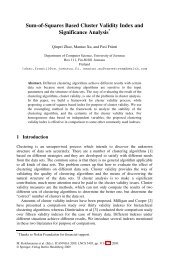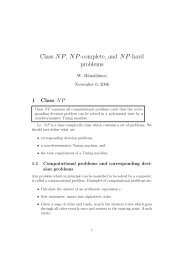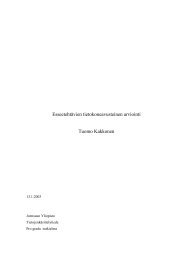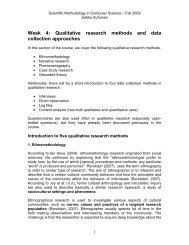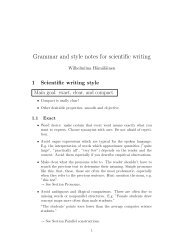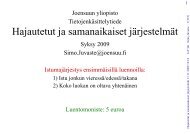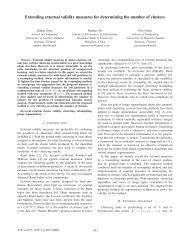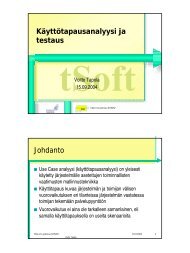Scientific Writing for Computer Science Students - FTP Directory ...
Scientific Writing for Computer Science Students - FTP Directory ...
Scientific Writing for Computer Science Students - FTP Directory ...
Create successful ePaper yourself
Turn your PDF publications into a flip-book with our unique Google optimized e-Paper software.
4.11. PARAGRAPHS 77If it is hard to divide a section into paragraph, list the things in a bulletlist. Arrange the items and give them mini-subheadings. All items underone such heading belong to one paragraph. Tell the topic (expressed in theheading) in the topic sentence.4.11.3 Introductory paragraphsIn the beginning of each chapter or a section having subsections, give 1-2introductory paragraphs. These paragraphs tell what the chapter or sectionis about, i.e. it introduces the topics of sections or subsections. In the beginningof a chapter you can also introduce the main theme or problem andmotivate the reader.Suggestion: just one brief paragraph in the beginning of a section, a longeror a couple of paragraphs in the beginning of a chapter.E.g. <strong>for</strong> the section ”Correlation analysis”:”In the following, we recall the most common measure <strong>for</strong> correlation, Pearsoncorrelation coefficient. We discuss restrictions and extensions of thecommon correlation analysis. Finally, we analyze the ViSCoS data by Pearsoncorrelation and correlation ratios to reveal linear and non-linear dependencies.”In the beginning of chapter ”Modelling dependencies between attributes”(could be briefer):”The main goal of predictive modelling is to predict a target variable Y froma set of other variables X = {X 1 , ..., X k } ⊆ R. Variables X are called explanarory,because they explain Y . The existence of such model requires thatY depends on X. Thus, the first step of modelling process is the descriptiveanalysis of dependencies between Y and X. The task is two-fold: First,we should select an attribute set X which best explains Y . Then we shouldanalyze the type of dependency. Given this in<strong>for</strong>mation, we can select the appropriatepredictive modelling paradigm and define restrictions <strong>for</strong> the modelstructure.In the following, we define the main types of dependencies <strong>for</strong> categorial andnumeric data. We introduce three techniques (correlation analysis, correlationratios, and multiple linear regression) <strong>for</strong> modelling dependencies innumeric data and four techniques (χ 2 independence test, mutual in<strong>for</strong>ma-



